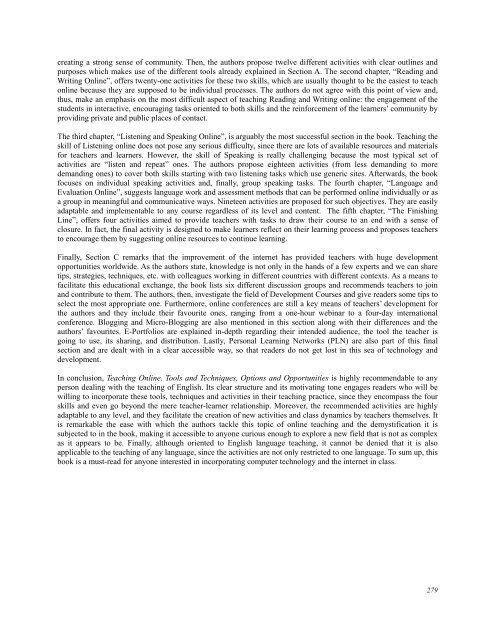October 2011 Volume 14 Number 4 - Educational Technology ...
October 2011 Volume 14 Number 4 - Educational Technology ...
October 2011 Volume 14 Number 4 - Educational Technology ...
You also want an ePaper? Increase the reach of your titles
YUMPU automatically turns print PDFs into web optimized ePapers that Google loves.
creating a strong sense of community. Then, the authors propose twelve different activities with clear outlines and<br />
purposes which makes use of the different tools already explained in Section A. The second chapter, “Reading and<br />
Writing Online”, offers twenty-one activities for these two skills, which are usually thought to be the easiest to teach<br />
online because they are supposed to be individual processes. The authors do not agree with this point of view and,<br />
thus, make an emphasis on the most difficult aspect of teaching Reading and Writing online: the engagement of the<br />
students in interactive, encouraging tasks oriented to both skills and the reinforcement of the learners’ community by<br />
providing private and public places of contact.<br />
The third chapter, “Listening and Speaking Online”, is arguably the most successful section in the book. Teaching the<br />
skill of Listening online does not pose any serious difficulty, since there are lots of available resources and materials<br />
for teachers and learners. However, the skill of Speaking is really challenging because the most typical set of<br />
activities are “listen and repeat” ones. The authors propose eighteen activities (from less demanding to more<br />
demanding ones) to cover both skills starting with two listening tasks which use generic sites. Afterwards, the book<br />
focuses on individual speaking activities and, finally, group speaking tasks. The fourth chapter, “Language and<br />
Evaluation Online”, suggests language work and assessment methods that can be performed online individually or as<br />
a group in meaningful and communicative ways. Nineteen activities are proposed for such objectives. They are easily<br />
adaptable and implementable to any course regardless of its level and content. The fifth chapter, “The Finishing<br />
Line”, offers four activities aimed to provide teachers with tasks to draw their course to an end with a sense of<br />
closure. In fact, the final activity is designed to make learners reflect on their learning process and proposes teachers<br />
to encourage them by suggesting online resources to continue learning.<br />
Finally, Section C remarks that the improvement of the internet has provided teachers with huge development<br />
opportunities worldwide. As the authors state, knowledge is not only in the hands of a few experts and we can share<br />
tips, strategies, techniques, etc. with colleagues working in different countries with different contexts. As a means to<br />
facilitate this educational exchange, the book lists six different discussion groups and recommends teachers to join<br />
and contribute to them. The authors, then, investigate the field of Development Courses and give readers some tips to<br />
select the most appropriate one. Furthermore, online conferences are still a key means of teachers’ development for<br />
the authors and they include their favourite ones, ranging from a one-hour webinar to a four-day international<br />
conference. Blogging and Micro-Blogging are also mentioned in this section along with their differences and the<br />
authors’ favourites. E-Portfolios are explained in-depth regarding their intended audience, the tool the teacher is<br />
going to use, its sharing, and distribution. Lastly, Personal Learning Networks (PLN) are also part of this final<br />
section and are dealt with in a clear accessible way, so that readers do not get lost in this sea of technology and<br />
development.<br />
In conclusion, Teaching Online. Tools and Techniques, Options and Opportunities is highly recommendable to any<br />
person dealing with the teaching of English. Its clear structure and its motivating tone engages readers who will be<br />
willing to incorporate these tools, techniques and activities in their teaching practice, since they encompass the four<br />
skills and even go beyond the mere teacher-learner relationship. Moreover, the recommended activities are highly<br />
adaptable to any level, and they facilitate the creation of new activities and class dynamics by teachers themselves. It<br />
is remarkable the ease with which the authors tackle this topic of online teaching and the demystification it is<br />
subjected to in the book, making it accessible to anyone curious enough to explore a new field that is not as complex<br />
as it appears to be. Finally, although oriented to English language teaching, it cannot be denied that it is also<br />
applicable to the teaching of any language, since the activities are not only restricted to one language. To sum up, this<br />
book is a must-read for anyone interested in incorporating computer technology and the internet in class.<br />
279

















